Analysis of Leadership and Management
VerifiedAdded on 2020/10/22
|15
|5081
|237
AI Summary
The assignment provided is a compilation of various sources on leadership and management, covering topics such as employee engagement, sustainability, and performance measurement systems. It includes definitions of leaders, insights into growth strategies, and key traits of successful leaders. The document also explores the role of incentives in employee performance and provides examples from companies like Toyota and IBM. A summary of the assignment is: This comprehensive analysis of leadership and management skills provides essential insights for professionals seeking to excel in today's competitive business environment.
Contribute Materials
Your contribution can guide someone’s learning journey. Share your
documents today.
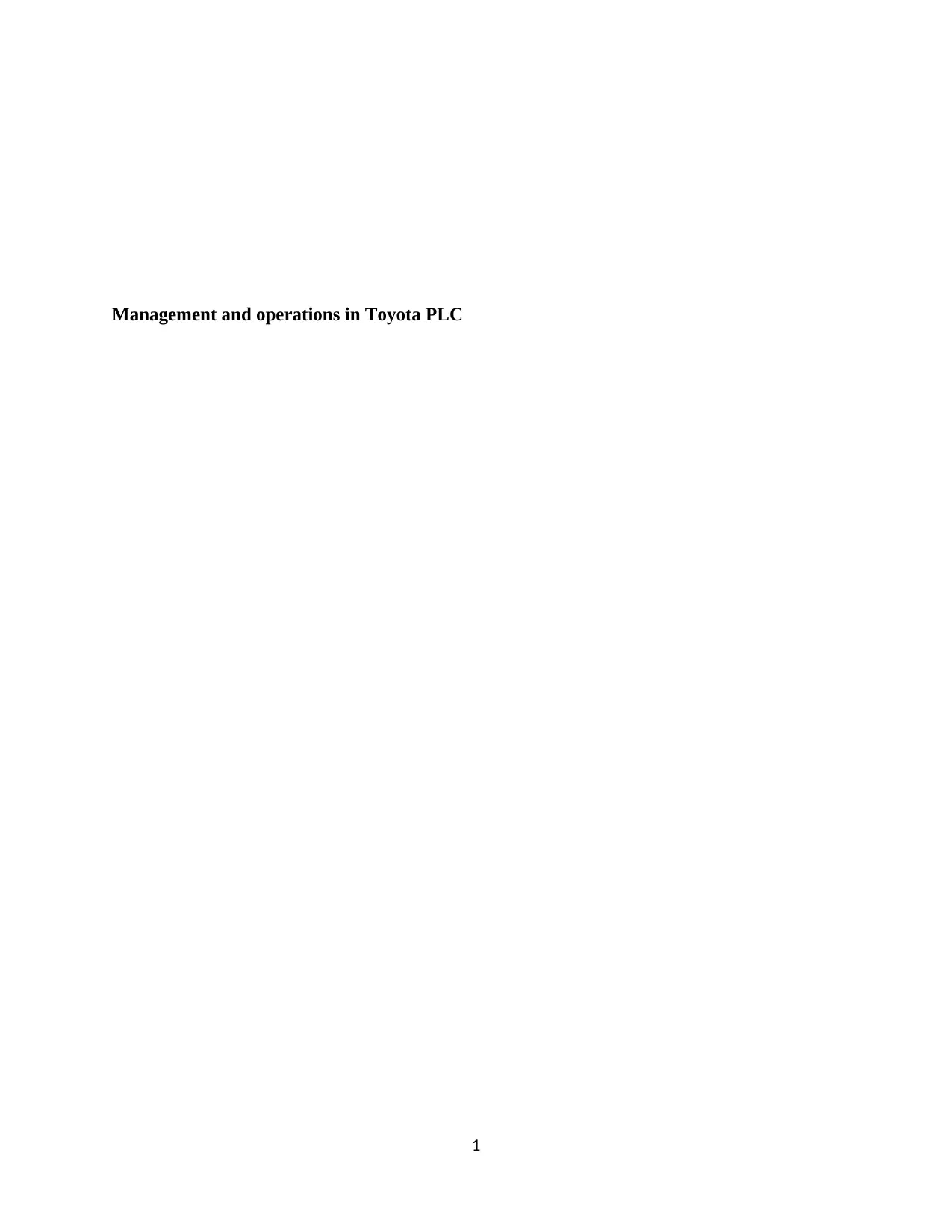
Management and operations in Toyota PLC
1
1
Secure Best Marks with AI Grader
Need help grading? Try our AI Grader for instant feedback on your assignments.

Table of Contents
Introduction.................................................................................................................................................4
LO1.............................................................................................................................................................4
P1 Define terms leader and manager and compare their different roles and characteristic traits.............4
LO2.............................................................................................................................................................6
P2 how role of leader and function of manager are different as per situations in which they are placed. 6
P3 Apply different theories and models of leadership in Toyota.............................................................7
LO3.............................................................................................................................................................9
P4 Approaches used for operations management in Toyota and the role played by leaders and managers
.................................................................................................................................................................9
LO4...........................................................................................................................................................10
P5 Explain the importance and value of operations management in achieving and sustaining Toyota’s
business objectives.................................................................................................................................10
P6 Access the factors within Toyota business environment that can impact upon operational
management and decision making by leaders and managers.................................................................11
Conclusion.................................................................................................................................................12
References.................................................................................................................................................13
2
Introduction.................................................................................................................................................4
LO1.............................................................................................................................................................4
P1 Define terms leader and manager and compare their different roles and characteristic traits.............4
LO2.............................................................................................................................................................6
P2 how role of leader and function of manager are different as per situations in which they are placed. 6
P3 Apply different theories and models of leadership in Toyota.............................................................7
LO3.............................................................................................................................................................9
P4 Approaches used for operations management in Toyota and the role played by leaders and managers
.................................................................................................................................................................9
LO4...........................................................................................................................................................10
P5 Explain the importance and value of operations management in achieving and sustaining Toyota’s
business objectives.................................................................................................................................10
P6 Access the factors within Toyota business environment that can impact upon operational
management and decision making by leaders and managers.................................................................11
Conclusion.................................................................................................................................................12
References.................................................................................................................................................13
2
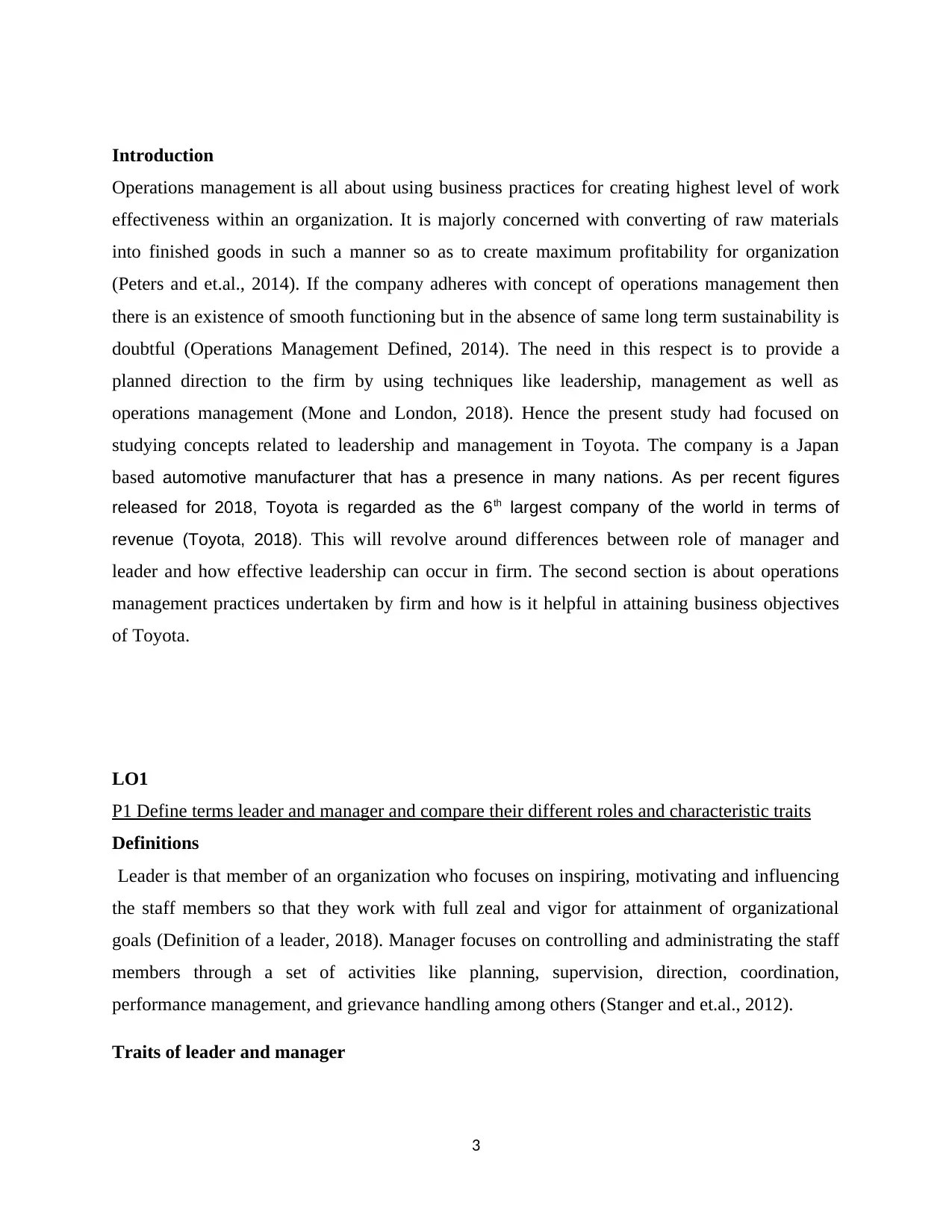
Introduction
Operations management is all about using business practices for creating highest level of work
effectiveness within an organization. It is majorly concerned with converting of raw materials
into finished goods in such a manner so as to create maximum profitability for organization
(Peters and et.al., 2014). If the company adheres with concept of operations management then
there is an existence of smooth functioning but in the absence of same long term sustainability is
doubtful (Operations Management Defined, 2014). The need in this respect is to provide a
planned direction to the firm by using techniques like leadership, management as well as
operations management (Mone and London, 2018). Hence the present study had focused on
studying concepts related to leadership and management in Toyota. The company is a Japan
based automotive manufacturer that has a presence in many nations. As per recent figures
released for 2018, Toyota is regarded as the 6th largest company of the world in terms of
revenue (Toyota, 2018). This will revolve around differences between role of manager and
leader and how effective leadership can occur in firm. The second section is about operations
management practices undertaken by firm and how is it helpful in attaining business objectives
of Toyota.
LO1
P1 Define terms leader and manager and compare their different roles and characteristic traits
Definitions
Leader is that member of an organization who focuses on inspiring, motivating and influencing
the staff members so that they work with full zeal and vigor for attainment of organizational
goals (Definition of a leader, 2018). Manager focuses on controlling and administrating the staff
members through a set of activities like planning, supervision, direction, coordination,
performance management, and grievance handling among others (Stanger and et.al., 2012).
Traits of leader and manager
3
Operations management is all about using business practices for creating highest level of work
effectiveness within an organization. It is majorly concerned with converting of raw materials
into finished goods in such a manner so as to create maximum profitability for organization
(Peters and et.al., 2014). If the company adheres with concept of operations management then
there is an existence of smooth functioning but in the absence of same long term sustainability is
doubtful (Operations Management Defined, 2014). The need in this respect is to provide a
planned direction to the firm by using techniques like leadership, management as well as
operations management (Mone and London, 2018). Hence the present study had focused on
studying concepts related to leadership and management in Toyota. The company is a Japan
based automotive manufacturer that has a presence in many nations. As per recent figures
released for 2018, Toyota is regarded as the 6th largest company of the world in terms of
revenue (Toyota, 2018). This will revolve around differences between role of manager and
leader and how effective leadership can occur in firm. The second section is about operations
management practices undertaken by firm and how is it helpful in attaining business objectives
of Toyota.
LO1
P1 Define terms leader and manager and compare their different roles and characteristic traits
Definitions
Leader is that member of an organization who focuses on inspiring, motivating and influencing
the staff members so that they work with full zeal and vigor for attainment of organizational
goals (Definition of a leader, 2018). Manager focuses on controlling and administrating the staff
members through a set of activities like planning, supervision, direction, coordination,
performance management, and grievance handling among others (Stanger and et.al., 2012).
Traits of leader and manager
3
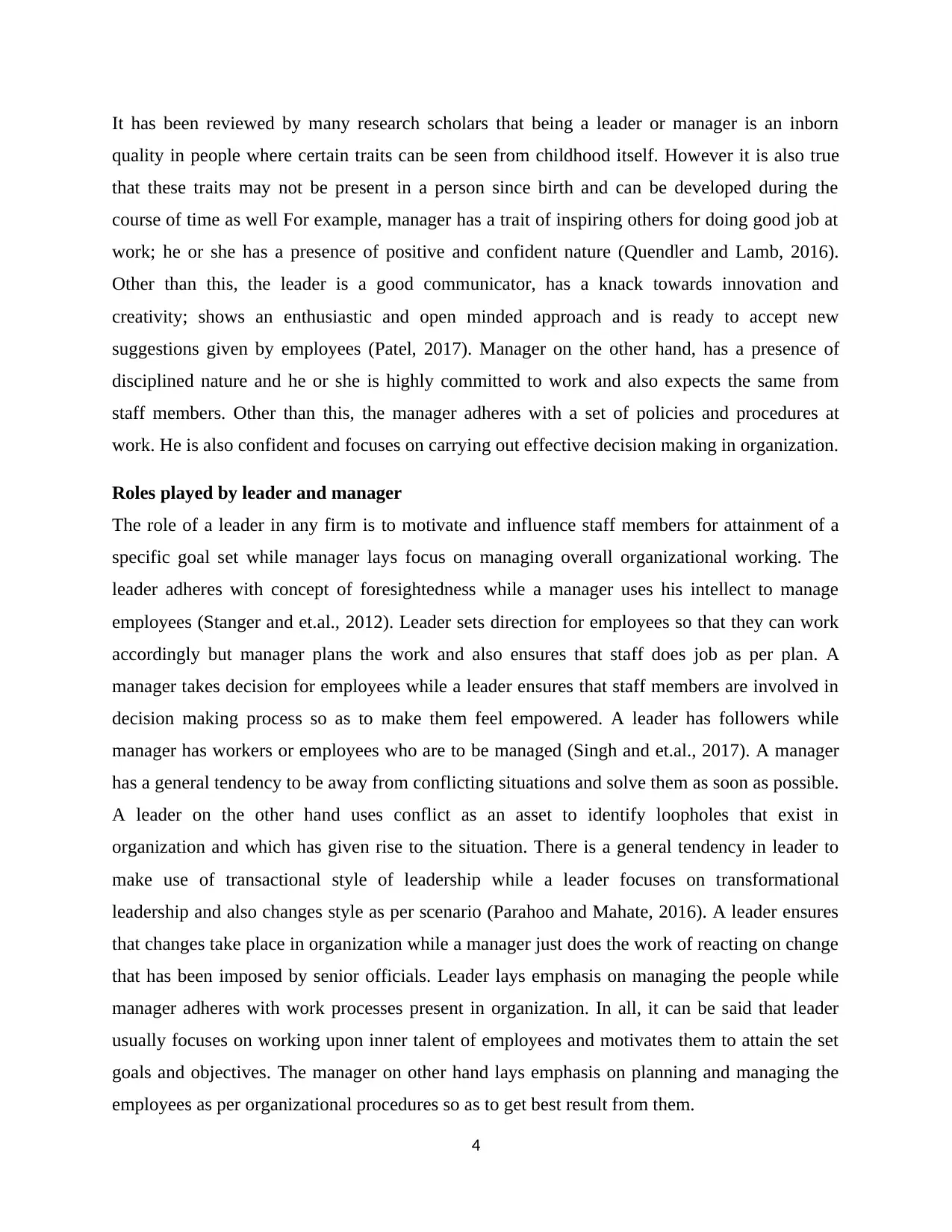
It has been reviewed by many research scholars that being a leader or manager is an inborn
quality in people where certain traits can be seen from childhood itself. However it is also true
that these traits may not be present in a person since birth and can be developed during the
course of time as well For example, manager has a trait of inspiring others for doing good job at
work; he or she has a presence of positive and confident nature (Quendler and Lamb, 2016).
Other than this, the leader is a good communicator, has a knack towards innovation and
creativity; shows an enthusiastic and open minded approach and is ready to accept new
suggestions given by employees (Patel, 2017). Manager on the other hand, has a presence of
disciplined nature and he or she is highly committed to work and also expects the same from
staff members. Other than this, the manager adheres with a set of policies and procedures at
work. He is also confident and focuses on carrying out effective decision making in organization.
Roles played by leader and manager
The role of a leader in any firm is to motivate and influence staff members for attainment of a
specific goal set while manager lays focus on managing overall organizational working. The
leader adheres with concept of foresightedness while a manager uses his intellect to manage
employees (Stanger and et.al., 2012). Leader sets direction for employees so that they can work
accordingly but manager plans the work and also ensures that staff does job as per plan. A
manager takes decision for employees while a leader ensures that staff members are involved in
decision making process so as to make them feel empowered. A leader has followers while
manager has workers or employees who are to be managed (Singh and et.al., 2017). A manager
has a general tendency to be away from conflicting situations and solve them as soon as possible.
A leader on the other hand uses conflict as an asset to identify loopholes that exist in
organization and which has given rise to the situation. There is a general tendency in leader to
make use of transactional style of leadership while a leader focuses on transformational
leadership and also changes style as per scenario (Parahoo and Mahate, 2016). A leader ensures
that changes take place in organization while a manager just does the work of reacting on change
that has been imposed by senior officials. Leader lays emphasis on managing the people while
manager adheres with work processes present in organization. In all, it can be said that leader
usually focuses on working upon inner talent of employees and motivates them to attain the set
goals and objectives. The manager on other hand lays emphasis on planning and managing the
employees as per organizational procedures so as to get best result from them.
4
quality in people where certain traits can be seen from childhood itself. However it is also true
that these traits may not be present in a person since birth and can be developed during the
course of time as well For example, manager has a trait of inspiring others for doing good job at
work; he or she has a presence of positive and confident nature (Quendler and Lamb, 2016).
Other than this, the leader is a good communicator, has a knack towards innovation and
creativity; shows an enthusiastic and open minded approach and is ready to accept new
suggestions given by employees (Patel, 2017). Manager on the other hand, has a presence of
disciplined nature and he or she is highly committed to work and also expects the same from
staff members. Other than this, the manager adheres with a set of policies and procedures at
work. He is also confident and focuses on carrying out effective decision making in organization.
Roles played by leader and manager
The role of a leader in any firm is to motivate and influence staff members for attainment of a
specific goal set while manager lays focus on managing overall organizational working. The
leader adheres with concept of foresightedness while a manager uses his intellect to manage
employees (Stanger and et.al., 2012). Leader sets direction for employees so that they can work
accordingly but manager plans the work and also ensures that staff does job as per plan. A
manager takes decision for employees while a leader ensures that staff members are involved in
decision making process so as to make them feel empowered. A leader has followers while
manager has workers or employees who are to be managed (Singh and et.al., 2017). A manager
has a general tendency to be away from conflicting situations and solve them as soon as possible.
A leader on the other hand uses conflict as an asset to identify loopholes that exist in
organization and which has given rise to the situation. There is a general tendency in leader to
make use of transactional style of leadership while a leader focuses on transformational
leadership and also changes style as per scenario (Parahoo and Mahate, 2016). A leader ensures
that changes take place in organization while a manager just does the work of reacting on change
that has been imposed by senior officials. Leader lays emphasis on managing the people while
manager adheres with work processes present in organization. In all, it can be said that leader
usually focuses on working upon inner talent of employees and motivates them to attain the set
goals and objectives. The manager on other hand lays emphasis on planning and managing the
employees as per organizational procedures so as to get best result from them.
4
Secure Best Marks with AI Grader
Need help grading? Try our AI Grader for instant feedback on your assignments.
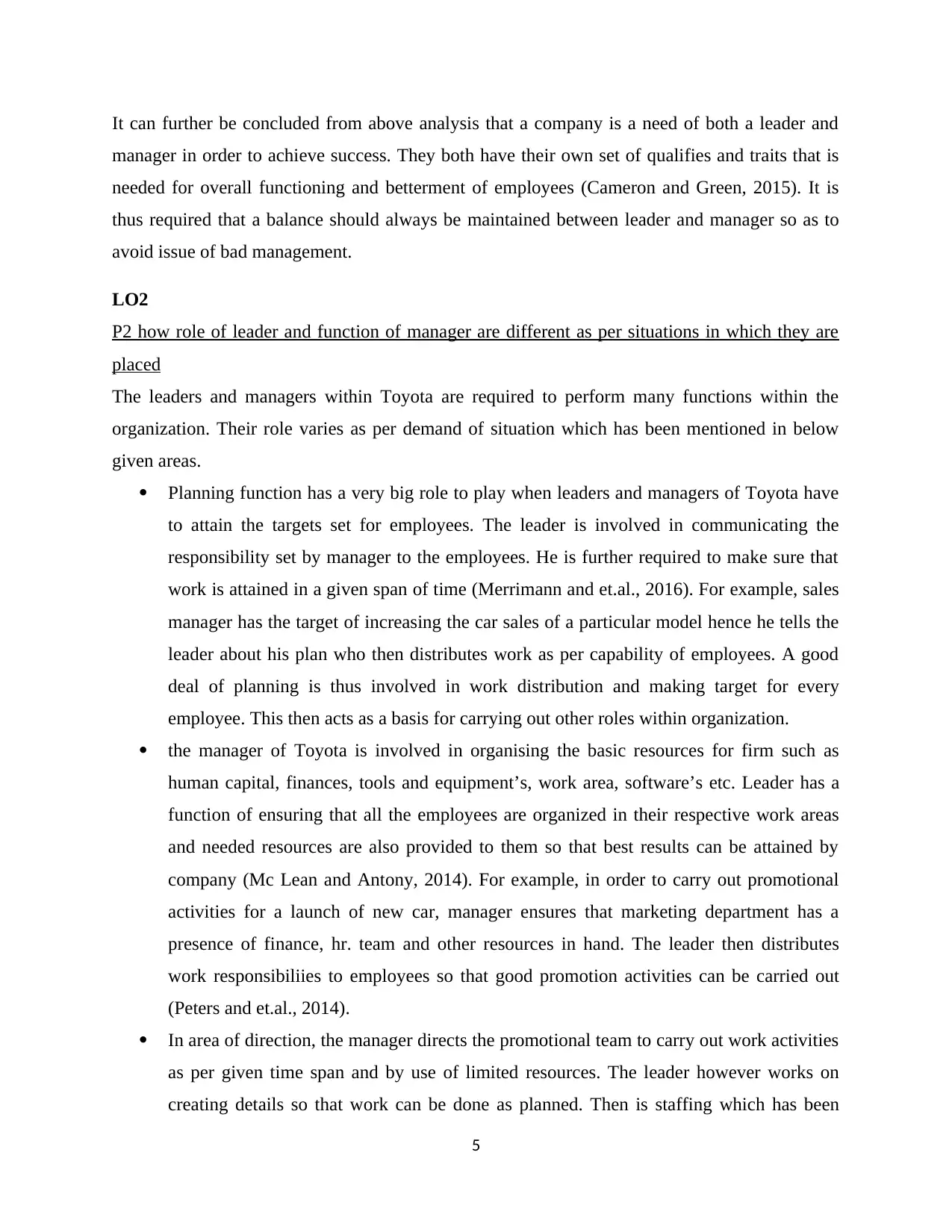
It can further be concluded from above analysis that a company is a need of both a leader and
manager in order to achieve success. They both have their own set of qualifies and traits that is
needed for overall functioning and betterment of employees (Cameron and Green, 2015). It is
thus required that a balance should always be maintained between leader and manager so as to
avoid issue of bad management.
LO2
P2 how role of leader and function of manager are different as per situations in which they are
placed
The leaders and managers within Toyota are required to perform many functions within the
organization. Their role varies as per demand of situation which has been mentioned in below
given areas.
Planning function has a very big role to play when leaders and managers of Toyota have
to attain the targets set for employees. The leader is involved in communicating the
responsibility set by manager to the employees. He is further required to make sure that
work is attained in a given span of time (Merrimann and et.al., 2016). For example, sales
manager has the target of increasing the car sales of a particular model hence he tells the
leader about his plan who then distributes work as per capability of employees. A good
deal of planning is thus involved in work distribution and making target for every
employee. This then acts as a basis for carrying out other roles within organization.
the manager of Toyota is involved in organising the basic resources for firm such as
human capital, finances, tools and equipment’s, work area, software’s etc. Leader has a
function of ensuring that all the employees are organized in their respective work areas
and needed resources are also provided to them so that best results can be attained by
company (Mc Lean and Antony, 2014). For example, in order to carry out promotional
activities for a launch of new car, manager ensures that marketing department has a
presence of finance, hr. team and other resources in hand. The leader then distributes
work responsibiliies to employees so that good promotion activities can be carried out
(Peters and et.al., 2014).
In area of direction, the manager directs the promotional team to carry out work activities
as per given time span and by use of limited resources. The leader however works on
creating details so that work can be done as planned. Then is staffing which has been
5
manager in order to achieve success. They both have their own set of qualifies and traits that is
needed for overall functioning and betterment of employees (Cameron and Green, 2015). It is
thus required that a balance should always be maintained between leader and manager so as to
avoid issue of bad management.
LO2
P2 how role of leader and function of manager are different as per situations in which they are
placed
The leaders and managers within Toyota are required to perform many functions within the
organization. Their role varies as per demand of situation which has been mentioned in below
given areas.
Planning function has a very big role to play when leaders and managers of Toyota have
to attain the targets set for employees. The leader is involved in communicating the
responsibility set by manager to the employees. He is further required to make sure that
work is attained in a given span of time (Merrimann and et.al., 2016). For example, sales
manager has the target of increasing the car sales of a particular model hence he tells the
leader about his plan who then distributes work as per capability of employees. A good
deal of planning is thus involved in work distribution and making target for every
employee. This then acts as a basis for carrying out other roles within organization.
the manager of Toyota is involved in organising the basic resources for firm such as
human capital, finances, tools and equipment’s, work area, software’s etc. Leader has a
function of ensuring that all the employees are organized in their respective work areas
and needed resources are also provided to them so that best results can be attained by
company (Mc Lean and Antony, 2014). For example, in order to carry out promotional
activities for a launch of new car, manager ensures that marketing department has a
presence of finance, hr. team and other resources in hand. The leader then distributes
work responsibiliies to employees so that good promotion activities can be carried out
(Peters and et.al., 2014).
In area of direction, the manager directs the promotional team to carry out work activities
as per given time span and by use of limited resources. The leader however works on
creating details so that work can be done as planned. Then is staffing which has been
5

regarded as one of the most significant functions to be performed by management and
leaders at Toyota (Muratbekova-Touron and Galindo, 2018). The manager focuses on
assessing the need for recruiting the number and kind of employees within department
and sends details to HR team. He is also involved in assigning work responsibilities as
per capabilities and skill set of employees. On other hand, leader is involved in
motivating employees and ensuring that they carry out work responsibilities to the best of
their capability. Leader further lays focus on maintaining two way communications in
both oral and written formats (Stanger and et.al., 2012). He is also involved in solving
grievances and carrying out performance evaluation.
Then comes coordination of the work processes carried out within Toyota so as to attain
better outcomes. This is necessary as any functional area cannot run independently and
need is to coordinate with other departments as well. Role of leaders in this respect is to
ensure that there is a presence of good communication in all departments so as to aid in
effective coordination (Upadhaya, Munir and Blount, 2014). Last but not least function is
of controlling were manager is involved in forming strategies by which employees can be
controlled. For example, in operations department of Toyota the strategies can be with
respect to setting standards for work performance, maintaining discipline, coming to
office on time, adhering with deadlines among others (Pitt and Koufopoulos, 2012). The
role of leader in this respect is to guide employees as per policies laid by manager. He
further makes sure that the procedures do not act as a burden for employees and they are
able to deliver best possible work as per circumstances.
P3 Apply different theories and models of leadership in Toyota
Toyota has been making use of various approaches for leading the employees. These have been
discussed in below mentioned sections;
Contingency model of leadership
This leadership theory is based on principle that there is no one best way to manage the
employees and style to be adopted by leader depends on the situation that is present in front of
him or her. The first step as per this model is selection of leadership styles that the leader is
familiar with and which suits his or her personality. Then is the next step which involves for
assessing the situations in which leader has been placed so that style can be adopted accordingly
6
leaders at Toyota (Muratbekova-Touron and Galindo, 2018). The manager focuses on
assessing the need for recruiting the number and kind of employees within department
and sends details to HR team. He is also involved in assigning work responsibilities as
per capabilities and skill set of employees. On other hand, leader is involved in
motivating employees and ensuring that they carry out work responsibilities to the best of
their capability. Leader further lays focus on maintaining two way communications in
both oral and written formats (Stanger and et.al., 2012). He is also involved in solving
grievances and carrying out performance evaluation.
Then comes coordination of the work processes carried out within Toyota so as to attain
better outcomes. This is necessary as any functional area cannot run independently and
need is to coordinate with other departments as well. Role of leaders in this respect is to
ensure that there is a presence of good communication in all departments so as to aid in
effective coordination (Upadhaya, Munir and Blount, 2014). Last but not least function is
of controlling were manager is involved in forming strategies by which employees can be
controlled. For example, in operations department of Toyota the strategies can be with
respect to setting standards for work performance, maintaining discipline, coming to
office on time, adhering with deadlines among others (Pitt and Koufopoulos, 2012). The
role of leader in this respect is to guide employees as per policies laid by manager. He
further makes sure that the procedures do not act as a burden for employees and they are
able to deliver best possible work as per circumstances.
P3 Apply different theories and models of leadership in Toyota
Toyota has been making use of various approaches for leading the employees. These have been
discussed in below mentioned sections;
Contingency model of leadership
This leadership theory is based on principle that there is no one best way to manage the
employees and style to be adopted by leader depends on the situation that is present in front of
him or her. The first step as per this model is selection of leadership styles that the leader is
familiar with and which suits his or her personality. Then is the next step which involves for
assessing the situations in which leader has been placed so that style can be adopted accordingly
6
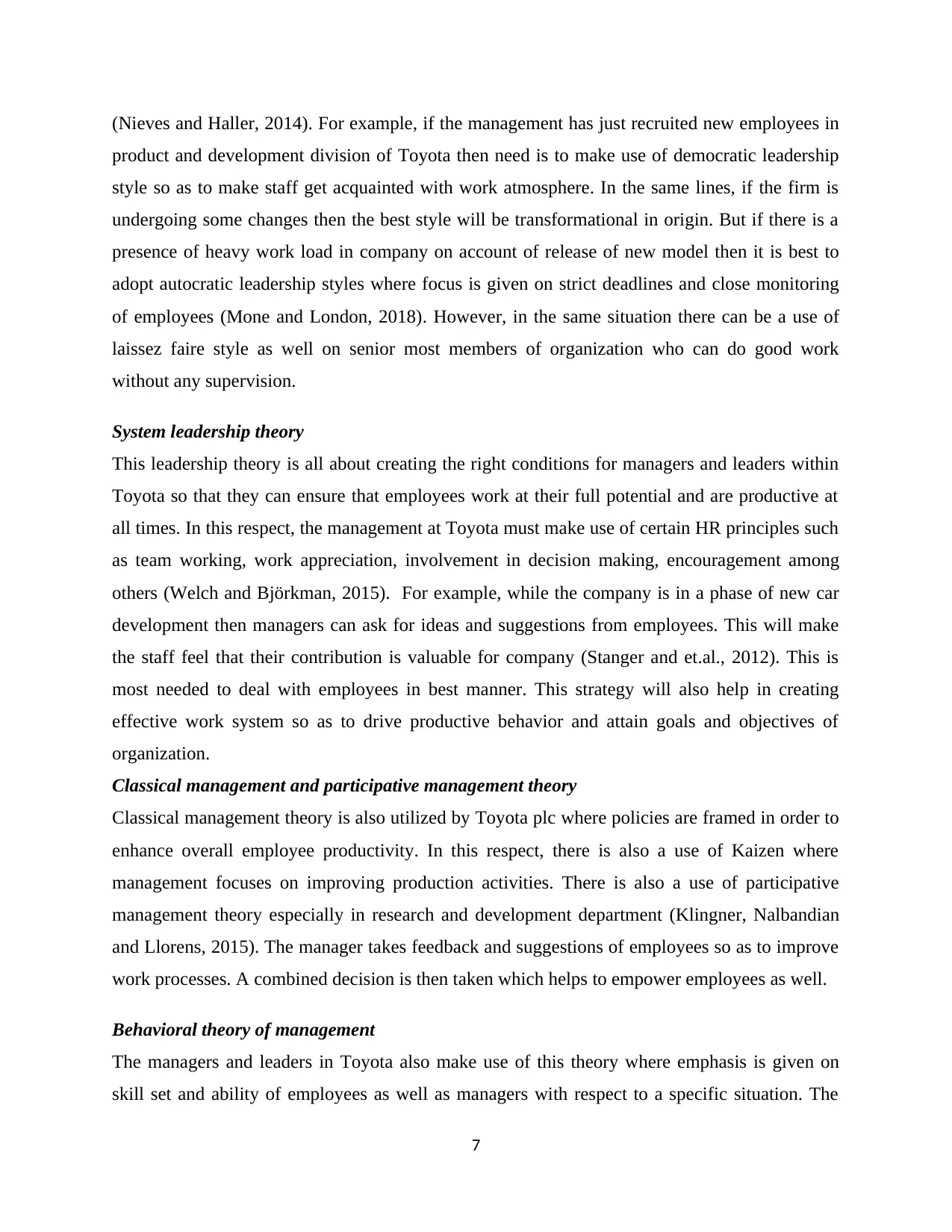
(Nieves and Haller, 2014). For example, if the management has just recruited new employees in
product and development division of Toyota then need is to make use of democratic leadership
style so as to make staff get acquainted with work atmosphere. In the same lines, if the firm is
undergoing some changes then the best style will be transformational in origin. But if there is a
presence of heavy work load in company on account of release of new model then it is best to
adopt autocratic leadership styles where focus is given on strict deadlines and close monitoring
of employees (Mone and London, 2018). However, in the same situation there can be a use of
laissez faire style as well on senior most members of organization who can do good work
without any supervision.
System leadership theory
This leadership theory is all about creating the right conditions for managers and leaders within
Toyota so that they can ensure that employees work at their full potential and are productive at
all times. In this respect, the management at Toyota must make use of certain HR principles such
as team working, work appreciation, involvement in decision making, encouragement among
others (Welch and Björkman, 2015). For example, while the company is in a phase of new car
development then managers can ask for ideas and suggestions from employees. This will make
the staff feel that their contribution is valuable for company (Stanger and et.al., 2012). This is
most needed to deal with employees in best manner. This strategy will also help in creating
effective work system so as to drive productive behavior and attain goals and objectives of
organization.
Classical management and participative management theory
Classical management theory is also utilized by Toyota plc where policies are framed in order to
enhance overall employee productivity. In this respect, there is also a use of Kaizen where
management focuses on improving production activities. There is also a use of participative
management theory especially in research and development department (Klingner, Nalbandian
and Llorens, 2015). The manager takes feedback and suggestions of employees so as to improve
work processes. A combined decision is then taken which helps to empower employees as well.
Behavioral theory of management
The managers and leaders in Toyota also make use of this theory where emphasis is given on
skill set and ability of employees as well as managers with respect to a specific situation. The
7
product and development division of Toyota then need is to make use of democratic leadership
style so as to make staff get acquainted with work atmosphere. In the same lines, if the firm is
undergoing some changes then the best style will be transformational in origin. But if there is a
presence of heavy work load in company on account of release of new model then it is best to
adopt autocratic leadership styles where focus is given on strict deadlines and close monitoring
of employees (Mone and London, 2018). However, in the same situation there can be a use of
laissez faire style as well on senior most members of organization who can do good work
without any supervision.
System leadership theory
This leadership theory is all about creating the right conditions for managers and leaders within
Toyota so that they can ensure that employees work at their full potential and are productive at
all times. In this respect, the management at Toyota must make use of certain HR principles such
as team working, work appreciation, involvement in decision making, encouragement among
others (Welch and Björkman, 2015). For example, while the company is in a phase of new car
development then managers can ask for ideas and suggestions from employees. This will make
the staff feel that their contribution is valuable for company (Stanger and et.al., 2012). This is
most needed to deal with employees in best manner. This strategy will also help in creating
effective work system so as to drive productive behavior and attain goals and objectives of
organization.
Classical management and participative management theory
Classical management theory is also utilized by Toyota plc where policies are framed in order to
enhance overall employee productivity. In this respect, there is also a use of Kaizen where
management focuses on improving production activities. There is also a use of participative
management theory especially in research and development department (Klingner, Nalbandian
and Llorens, 2015). The manager takes feedback and suggestions of employees so as to improve
work processes. A combined decision is then taken which helps to empower employees as well.
Behavioral theory of management
The managers and leaders in Toyota also make use of this theory where emphasis is given on
skill set and ability of employees as well as managers with respect to a specific situation. The
7
Paraphrase This Document
Need a fresh take? Get an instant paraphrase of this document with our AI Paraphraser
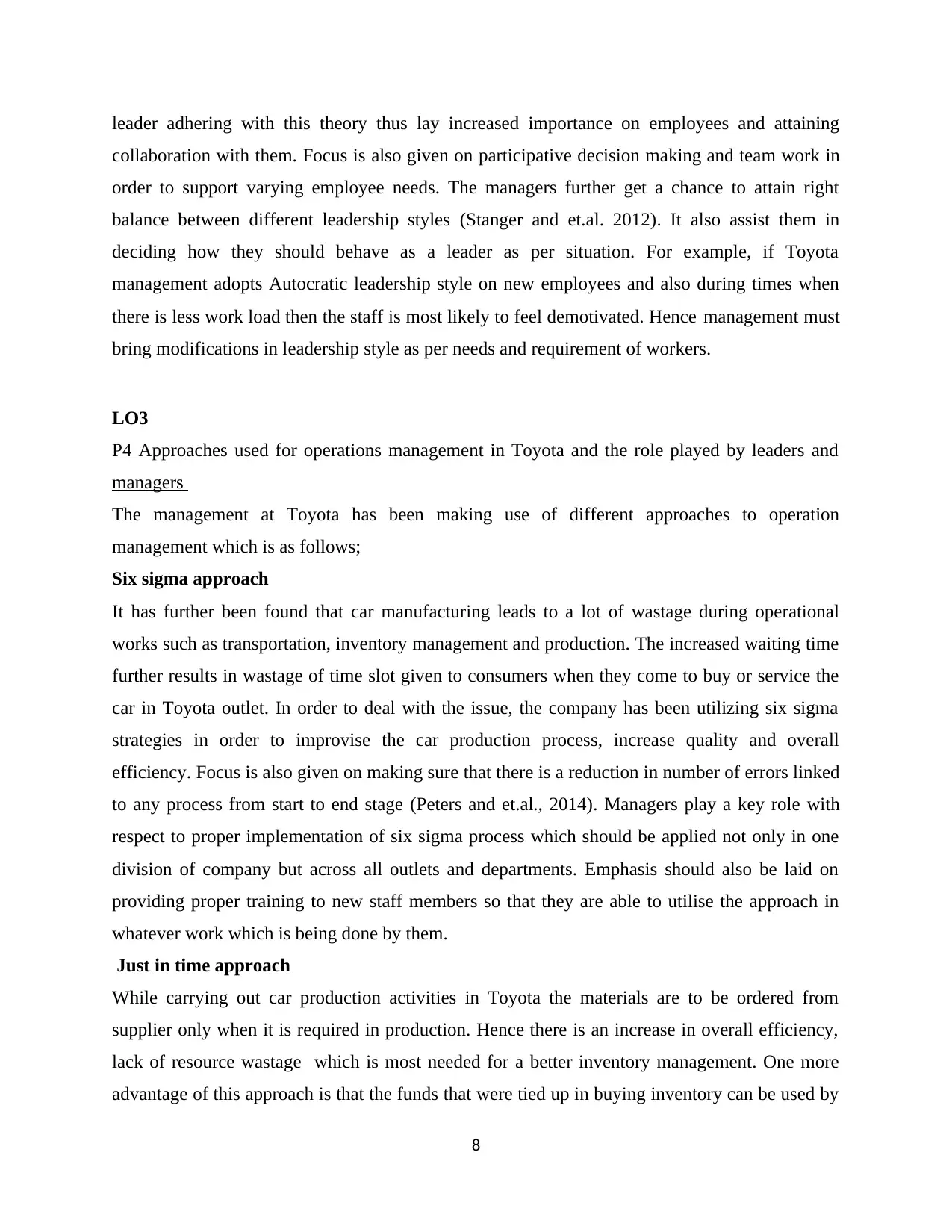
leader adhering with this theory thus lay increased importance on employees and attaining
collaboration with them. Focus is also given on participative decision making and team work in
order to support varying employee needs. The managers further get a chance to attain right
balance between different leadership styles (Stanger and et.al. 2012). It also assist them in
deciding how they should behave as a leader as per situation. For example, if Toyota
management adopts Autocratic leadership style on new employees and also during times when
there is less work load then the staff is most likely to feel demotivated. Hence management must
bring modifications in leadership style as per needs and requirement of workers.
LO3
P4 Approaches used for operations management in Toyota and the role played by leaders and
managers
The management at Toyota has been making use of different approaches to operation
management which is as follows;
Six sigma approach
It has further been found that car manufacturing leads to a lot of wastage during operational
works such as transportation, inventory management and production. The increased waiting time
further results in wastage of time slot given to consumers when they come to buy or service the
car in Toyota outlet. In order to deal with the issue, the company has been utilizing six sigma
strategies in order to improvise the car production process, increase quality and overall
efficiency. Focus is also given on making sure that there is a reduction in number of errors linked
to any process from start to end stage (Peters and et.al., 2014). Managers play a key role with
respect to proper implementation of six sigma process which should be applied not only in one
division of company but across all outlets and departments. Emphasis should also be laid on
providing proper training to new staff members so that they are able to utilise the approach in
whatever work which is being done by them.
Just in time approach
While carrying out car production activities in Toyota the materials are to be ordered from
supplier only when it is required in production. Hence there is an increase in overall efficiency,
lack of resource wastage which is most needed for a better inventory management. One more
advantage of this approach is that the funds that were tied up in buying inventory can be used by
8
collaboration with them. Focus is also given on participative decision making and team work in
order to support varying employee needs. The managers further get a chance to attain right
balance between different leadership styles (Stanger and et.al. 2012). It also assist them in
deciding how they should behave as a leader as per situation. For example, if Toyota
management adopts Autocratic leadership style on new employees and also during times when
there is less work load then the staff is most likely to feel demotivated. Hence management must
bring modifications in leadership style as per needs and requirement of workers.
LO3
P4 Approaches used for operations management in Toyota and the role played by leaders and
managers
The management at Toyota has been making use of different approaches to operation
management which is as follows;
Six sigma approach
It has further been found that car manufacturing leads to a lot of wastage during operational
works such as transportation, inventory management and production. The increased waiting time
further results in wastage of time slot given to consumers when they come to buy or service the
car in Toyota outlet. In order to deal with the issue, the company has been utilizing six sigma
strategies in order to improvise the car production process, increase quality and overall
efficiency. Focus is also given on making sure that there is a reduction in number of errors linked
to any process from start to end stage (Peters and et.al., 2014). Managers play a key role with
respect to proper implementation of six sigma process which should be applied not only in one
division of company but across all outlets and departments. Emphasis should also be laid on
providing proper training to new staff members so that they are able to utilise the approach in
whatever work which is being done by them.
Just in time approach
While carrying out car production activities in Toyota the materials are to be ordered from
supplier only when it is required in production. Hence there is an increase in overall efficiency,
lack of resource wastage which is most needed for a better inventory management. One more
advantage of this approach is that the funds that were tied up in buying inventory can be used by
8

management for other purposes such as promoting newly launched cars or carrying out research
activities in maximizing fuel efficiency (Mone and London, 2018). In the same way, those
warehouses that were devoted to storage of inventory can also be used for other purposes. This
thus leads to a better operation management in Toyota and also aids in increasing overall profit
figures.
Total quality management
From the research studies done by different authors it has been found that Toyota car maker is a
king of TQM. This is as the firm followed concept of keeping consumers first and involving staff
members in all operational areas. For example, the firm has begun a Creative Idea Suggestion
System where the staff members are encouraged to render valuable suggestions for betterment of
company. There is further a presence of Statistical Quality Control to ensure that all the
operation done by company is maintaining the set quality standards (Stanger and et.al., 2012).
The management further gives immense focus on bring improvement in product quality of
vehicles as well as after sales services that are offered to the consumers. For example, the cars
are made fuel efficient, safety aspect is taken care, reducing service waiting time, solving queries
of employees promptly of among others. These concepts are not only practiced in production
department but in sales, consumer service, marketing as well. The goal is to ensure that all
operations of company adhere with quality.
Continuous improvement or Kaizen
This approach can be defined as the one where all function of business are improved on a
continuous basis. Toyota has been following this approach to being a reduction in waste and
attains high levels of quality. Role of management in this respect is to ensure that all team
members are aware of this concept and train those staff who are not. They are also required to
assist the employees when they face any issue while adhering with this approach.
LO4
P5 Explain the importance and value of operations management in achieving and sustaining
Toyota’s business objectives
Operations management is a very important aspect of Toyota’s business operations as it is the
heart and soul of organization. This area within Toyota deals with designing of automobiles,
9
activities in maximizing fuel efficiency (Mone and London, 2018). In the same way, those
warehouses that were devoted to storage of inventory can also be used for other purposes. This
thus leads to a better operation management in Toyota and also aids in increasing overall profit
figures.
Total quality management
From the research studies done by different authors it has been found that Toyota car maker is a
king of TQM. This is as the firm followed concept of keeping consumers first and involving staff
members in all operational areas. For example, the firm has begun a Creative Idea Suggestion
System where the staff members are encouraged to render valuable suggestions for betterment of
company. There is further a presence of Statistical Quality Control to ensure that all the
operation done by company is maintaining the set quality standards (Stanger and et.al., 2012).
The management further gives immense focus on bring improvement in product quality of
vehicles as well as after sales services that are offered to the consumers. For example, the cars
are made fuel efficient, safety aspect is taken care, reducing service waiting time, solving queries
of employees promptly of among others. These concepts are not only practiced in production
department but in sales, consumer service, marketing as well. The goal is to ensure that all
operations of company adhere with quality.
Continuous improvement or Kaizen
This approach can be defined as the one where all function of business are improved on a
continuous basis. Toyota has been following this approach to being a reduction in waste and
attains high levels of quality. Role of management in this respect is to ensure that all team
members are aware of this concept and train those staff who are not. They are also required to
assist the employees when they face any issue while adhering with this approach.
LO4
P5 Explain the importance and value of operations management in achieving and sustaining
Toyota’s business objectives
Operations management is a very important aspect of Toyota’s business operations as it is the
heart and soul of organization. This area within Toyota deals with designing of automobiles,
9
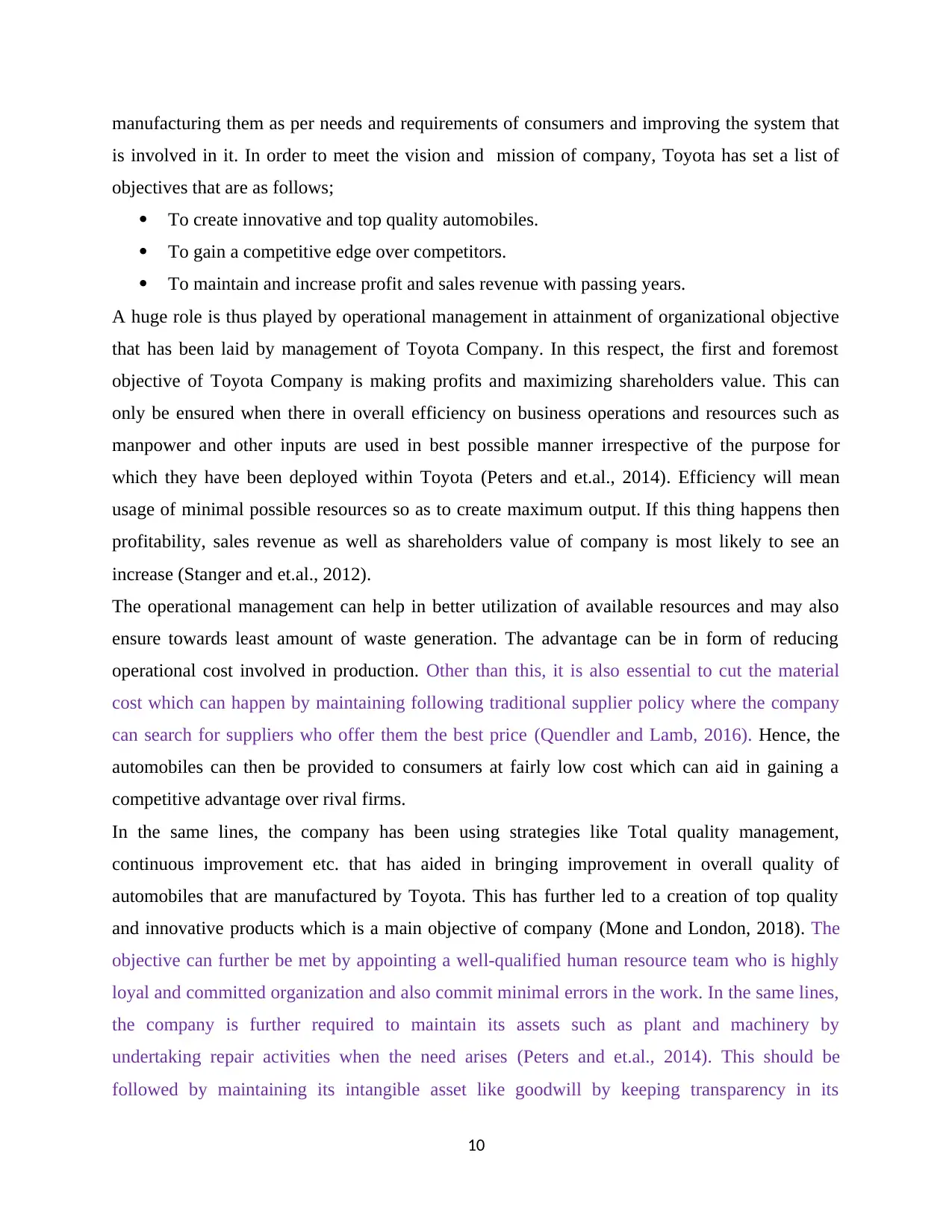
manufacturing them as per needs and requirements of consumers and improving the system that
is involved in it. In order to meet the vision and mission of company, Toyota has set a list of
objectives that are as follows;
To create innovative and top quality automobiles.
To gain a competitive edge over competitors.
To maintain and increase profit and sales revenue with passing years.
A huge role is thus played by operational management in attainment of organizational objective
that has been laid by management of Toyota Company. In this respect, the first and foremost
objective of Toyota Company is making profits and maximizing shareholders value. This can
only be ensured when there in overall efficiency on business operations and resources such as
manpower and other inputs are used in best possible manner irrespective of the purpose for
which they have been deployed within Toyota (Peters and et.al., 2014). Efficiency will mean
usage of minimal possible resources so as to create maximum output. If this thing happens then
profitability, sales revenue as well as shareholders value of company is most likely to see an
increase (Stanger and et.al., 2012).
The operational management can help in better utilization of available resources and may also
ensure towards least amount of waste generation. The advantage can be in form of reducing
operational cost involved in production. Other than this, it is also essential to cut the material
cost which can happen by maintaining following traditional supplier policy where the company
can search for suppliers who offer them the best price (Quendler and Lamb, 2016). Hence, the
automobiles can then be provided to consumers at fairly low cost which can aid in gaining a
competitive advantage over rival firms.
In the same lines, the company has been using strategies like Total quality management,
continuous improvement etc. that has aided in bringing improvement in overall quality of
automobiles that are manufactured by Toyota. This has further led to a creation of top quality
and innovative products which is a main objective of company (Mone and London, 2018). The
objective can further be met by appointing a well-qualified human resource team who is highly
loyal and committed organization and also commit minimal errors in the work. In the same lines,
the company is further required to maintain its assets such as plant and machinery by
undertaking repair activities when the need arises (Peters and et.al., 2014). This should be
followed by maintaining its intangible asset like goodwill by keeping transparency in its
10
is involved in it. In order to meet the vision and mission of company, Toyota has set a list of
objectives that are as follows;
To create innovative and top quality automobiles.
To gain a competitive edge over competitors.
To maintain and increase profit and sales revenue with passing years.
A huge role is thus played by operational management in attainment of organizational objective
that has been laid by management of Toyota Company. In this respect, the first and foremost
objective of Toyota Company is making profits and maximizing shareholders value. This can
only be ensured when there in overall efficiency on business operations and resources such as
manpower and other inputs are used in best possible manner irrespective of the purpose for
which they have been deployed within Toyota (Peters and et.al., 2014). Efficiency will mean
usage of minimal possible resources so as to create maximum output. If this thing happens then
profitability, sales revenue as well as shareholders value of company is most likely to see an
increase (Stanger and et.al., 2012).
The operational management can help in better utilization of available resources and may also
ensure towards least amount of waste generation. The advantage can be in form of reducing
operational cost involved in production. Other than this, it is also essential to cut the material
cost which can happen by maintaining following traditional supplier policy where the company
can search for suppliers who offer them the best price (Quendler and Lamb, 2016). Hence, the
automobiles can then be provided to consumers at fairly low cost which can aid in gaining a
competitive advantage over rival firms.
In the same lines, the company has been using strategies like Total quality management,
continuous improvement etc. that has aided in bringing improvement in overall quality of
automobiles that are manufactured by Toyota. This has further led to a creation of top quality
and innovative products which is a main objective of company (Mone and London, 2018). The
objective can further be met by appointing a well-qualified human resource team who is highly
loyal and committed organization and also commit minimal errors in the work. In the same lines,
the company is further required to maintain its assets such as plant and machinery by
undertaking repair activities when the need arises (Peters and et.al., 2014). This should be
followed by maintaining its intangible asset like goodwill by keeping transparency in its
10
Secure Best Marks with AI Grader
Need help grading? Try our AI Grader for instant feedback on your assignments.
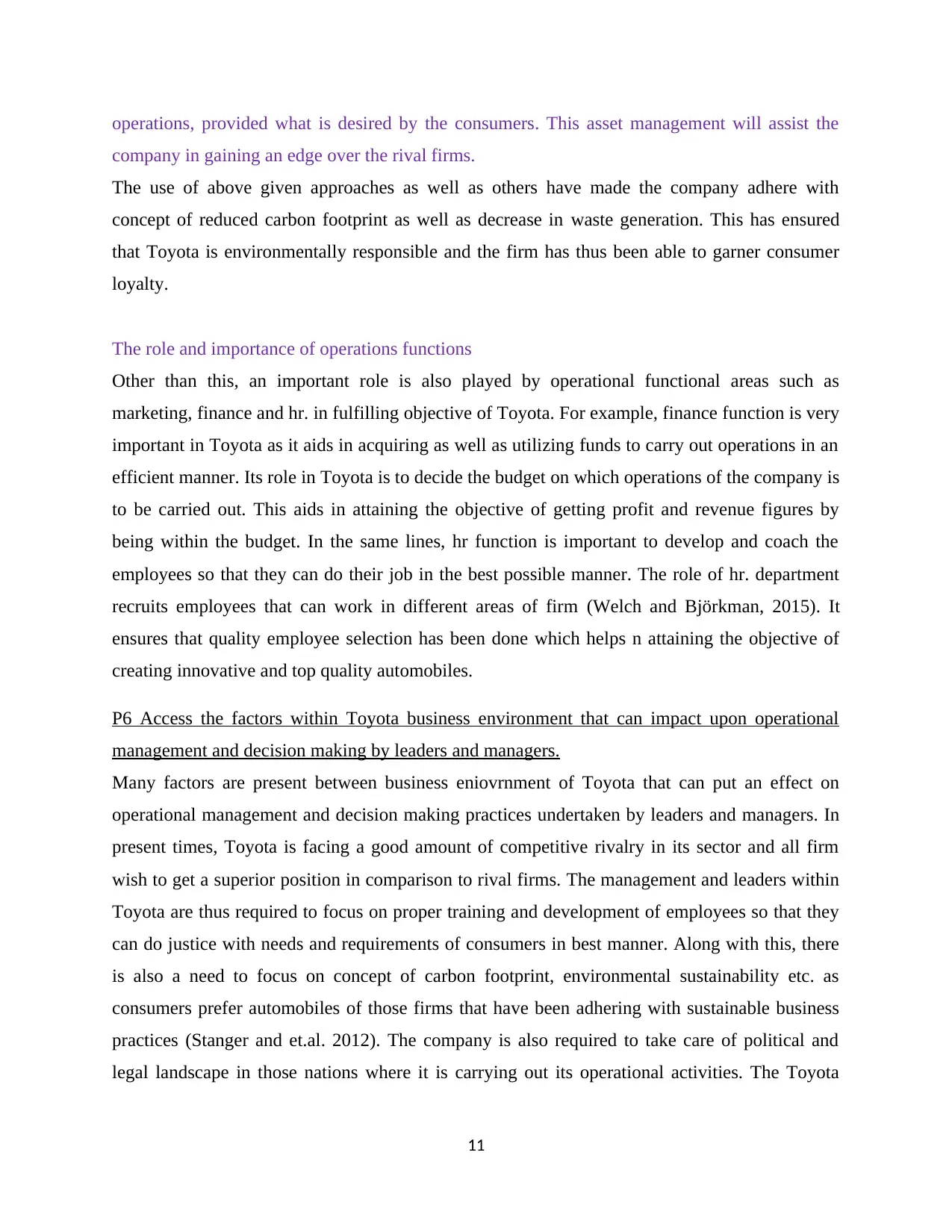
operations, provided what is desired by the consumers. This asset management will assist the
company in gaining an edge over the rival firms.
The use of above given approaches as well as others have made the company adhere with
concept of reduced carbon footprint as well as decrease in waste generation. This has ensured
that Toyota is environmentally responsible and the firm has thus been able to garner consumer
loyalty.
The role and importance of operations functions
Other than this, an important role is also played by operational functional areas such as
marketing, finance and hr. in fulfilling objective of Toyota. For example, finance function is very
important in Toyota as it aids in acquiring as well as utilizing funds to carry out operations in an
efficient manner. Its role in Toyota is to decide the budget on which operations of the company is
to be carried out. This aids in attaining the objective of getting profit and revenue figures by
being within the budget. In the same lines, hr function is important to develop and coach the
employees so that they can do their job in the best possible manner. The role of hr. department
recruits employees that can work in different areas of firm (Welch and Björkman, 2015). It
ensures that quality employee selection has been done which helps n attaining the objective of
creating innovative and top quality automobiles.
P6 Access the factors within Toyota business environment that can impact upon operational
management and decision making by leaders and managers.
Many factors are present between business eniovrnment of Toyota that can put an effect on
operational management and decision making practices undertaken by leaders and managers. In
present times, Toyota is facing a good amount of competitive rivalry in its sector and all firm
wish to get a superior position in comparison to rival firms. The management and leaders within
Toyota are thus required to focus on proper training and development of employees so that they
can do justice with needs and requirements of consumers in best manner. Along with this, there
is also a need to focus on concept of carbon footprint, environmental sustainability etc. as
consumers prefer automobiles of those firms that have been adhering with sustainable business
practices (Stanger and et.al. 2012). The company is also required to take care of political and
legal landscape in those nations where it is carrying out its operational activities. The Toyota
11
company in gaining an edge over the rival firms.
The use of above given approaches as well as others have made the company adhere with
concept of reduced carbon footprint as well as decrease in waste generation. This has ensured
that Toyota is environmentally responsible and the firm has thus been able to garner consumer
loyalty.
The role and importance of operations functions
Other than this, an important role is also played by operational functional areas such as
marketing, finance and hr. in fulfilling objective of Toyota. For example, finance function is very
important in Toyota as it aids in acquiring as well as utilizing funds to carry out operations in an
efficient manner. Its role in Toyota is to decide the budget on which operations of the company is
to be carried out. This aids in attaining the objective of getting profit and revenue figures by
being within the budget. In the same lines, hr function is important to develop and coach the
employees so that they can do their job in the best possible manner. The role of hr. department
recruits employees that can work in different areas of firm (Welch and Björkman, 2015). It
ensures that quality employee selection has been done which helps n attaining the objective of
creating innovative and top quality automobiles.
P6 Access the factors within Toyota business environment that can impact upon operational
management and decision making by leaders and managers.
Many factors are present between business eniovrnment of Toyota that can put an effect on
operational management and decision making practices undertaken by leaders and managers. In
present times, Toyota is facing a good amount of competitive rivalry in its sector and all firm
wish to get a superior position in comparison to rival firms. The management and leaders within
Toyota are thus required to focus on proper training and development of employees so that they
can do justice with needs and requirements of consumers in best manner. Along with this, there
is also a need to focus on concept of carbon footprint, environmental sustainability etc. as
consumers prefer automobiles of those firms that have been adhering with sustainable business
practices (Stanger and et.al. 2012). The company is also required to take care of political and
legal landscape in those nations where it is carrying out its operational activities. The Toyota
11
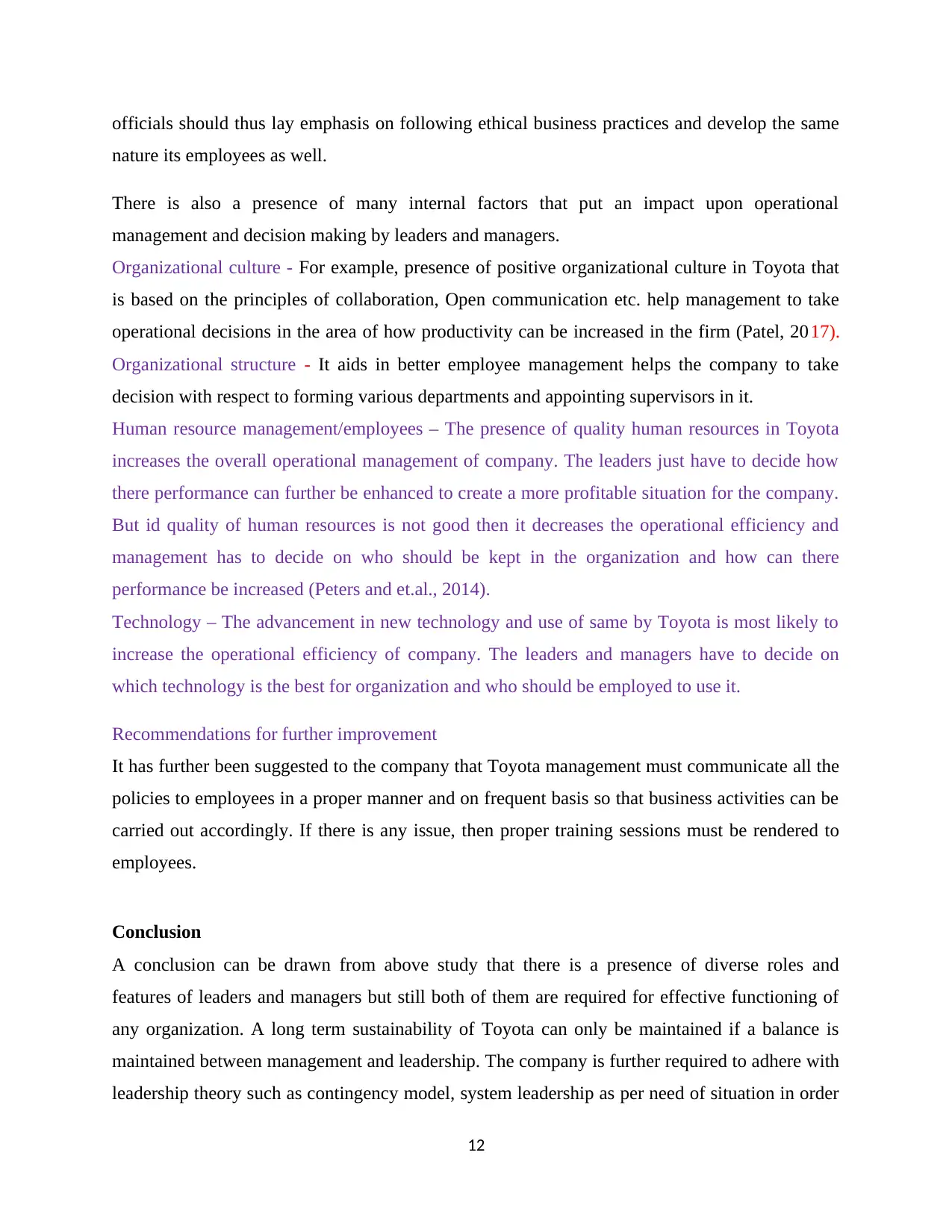
officials should thus lay emphasis on following ethical business practices and develop the same
nature its employees as well.
There is also a presence of many internal factors that put an impact upon operational
management and decision making by leaders and managers.
Organizational culture - For example, presence of positive organizational culture in Toyota that
is based on the principles of collaboration, Open communication etc. help management to take
operational decisions in the area of how productivity can be increased in the firm (Patel, 2017).
Organizational structure - It aids in better employee management helps the company to take
decision with respect to forming various departments and appointing supervisors in it.
Human resource management/employees – The presence of quality human resources in Toyota
increases the overall operational management of company. The leaders just have to decide how
there performance can further be enhanced to create a more profitable situation for the company.
But id quality of human resources is not good then it decreases the operational efficiency and
management has to decide on who should be kept in the organization and how can there
performance be increased (Peters and et.al., 2014).
Technology – The advancement in new technology and use of same by Toyota is most likely to
increase the operational efficiency of company. The leaders and managers have to decide on
which technology is the best for organization and who should be employed to use it.
Recommendations for further improvement
It has further been suggested to the company that Toyota management must communicate all the
policies to employees in a proper manner and on frequent basis so that business activities can be
carried out accordingly. If there is any issue, then proper training sessions must be rendered to
employees.
Conclusion
A conclusion can be drawn from above study that there is a presence of diverse roles and
features of leaders and managers but still both of them are required for effective functioning of
any organization. A long term sustainability of Toyota can only be maintained if a balance is
maintained between management and leadership. The company is further required to adhere with
leadership theory such as contingency model, system leadership as per need of situation in order
12
nature its employees as well.
There is also a presence of many internal factors that put an impact upon operational
management and decision making by leaders and managers.
Organizational culture - For example, presence of positive organizational culture in Toyota that
is based on the principles of collaboration, Open communication etc. help management to take
operational decisions in the area of how productivity can be increased in the firm (Patel, 2017).
Organizational structure - It aids in better employee management helps the company to take
decision with respect to forming various departments and appointing supervisors in it.
Human resource management/employees – The presence of quality human resources in Toyota
increases the overall operational management of company. The leaders just have to decide how
there performance can further be enhanced to create a more profitable situation for the company.
But id quality of human resources is not good then it decreases the operational efficiency and
management has to decide on who should be kept in the organization and how can there
performance be increased (Peters and et.al., 2014).
Technology – The advancement in new technology and use of same by Toyota is most likely to
increase the operational efficiency of company. The leaders and managers have to decide on
which technology is the best for organization and who should be employed to use it.
Recommendations for further improvement
It has further been suggested to the company that Toyota management must communicate all the
policies to employees in a proper manner and on frequent basis so that business activities can be
carried out accordingly. If there is any issue, then proper training sessions must be rendered to
employees.
Conclusion
A conclusion can be drawn from above study that there is a presence of diverse roles and
features of leaders and managers but still both of them are required for effective functioning of
any organization. A long term sustainability of Toyota can only be maintained if a balance is
maintained between management and leadership. The company is further required to adhere with
leadership theory such as contingency model, system leadership as per need of situation in order
12
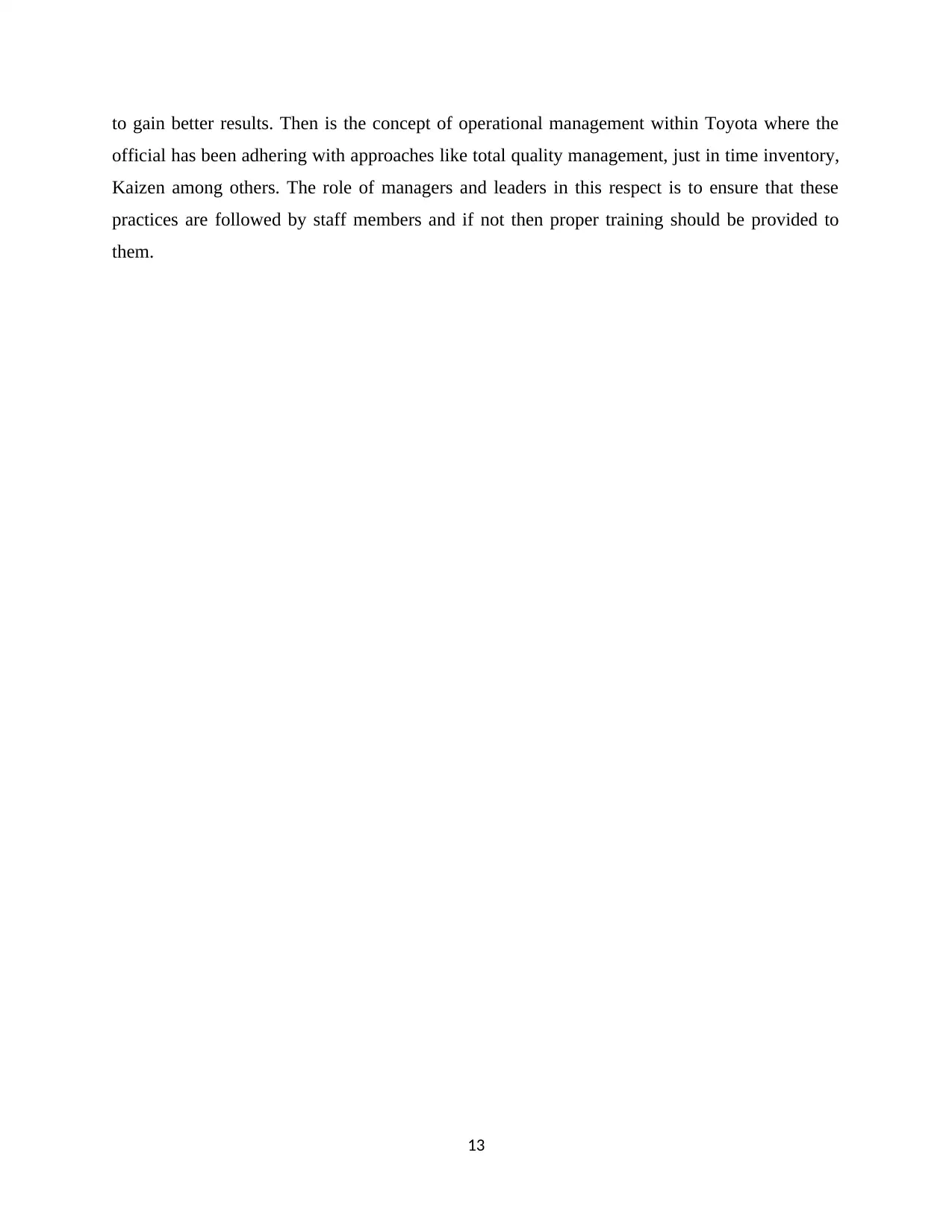
to gain better results. Then is the concept of operational management within Toyota where the
official has been adhering with approaches like total quality management, just in time inventory,
Kaizen among others. The role of managers and leaders in this respect is to ensure that these
practices are followed by staff members and if not then proper training should be provided to
them.
13
official has been adhering with approaches like total quality management, just in time inventory,
Kaizen among others. The role of managers and leaders in this respect is to ensure that these
practices are followed by staff members and if not then proper training should be provided to
them.
13
Paraphrase This Document
Need a fresh take? Get an instant paraphrase of this document with our AI Paraphraser
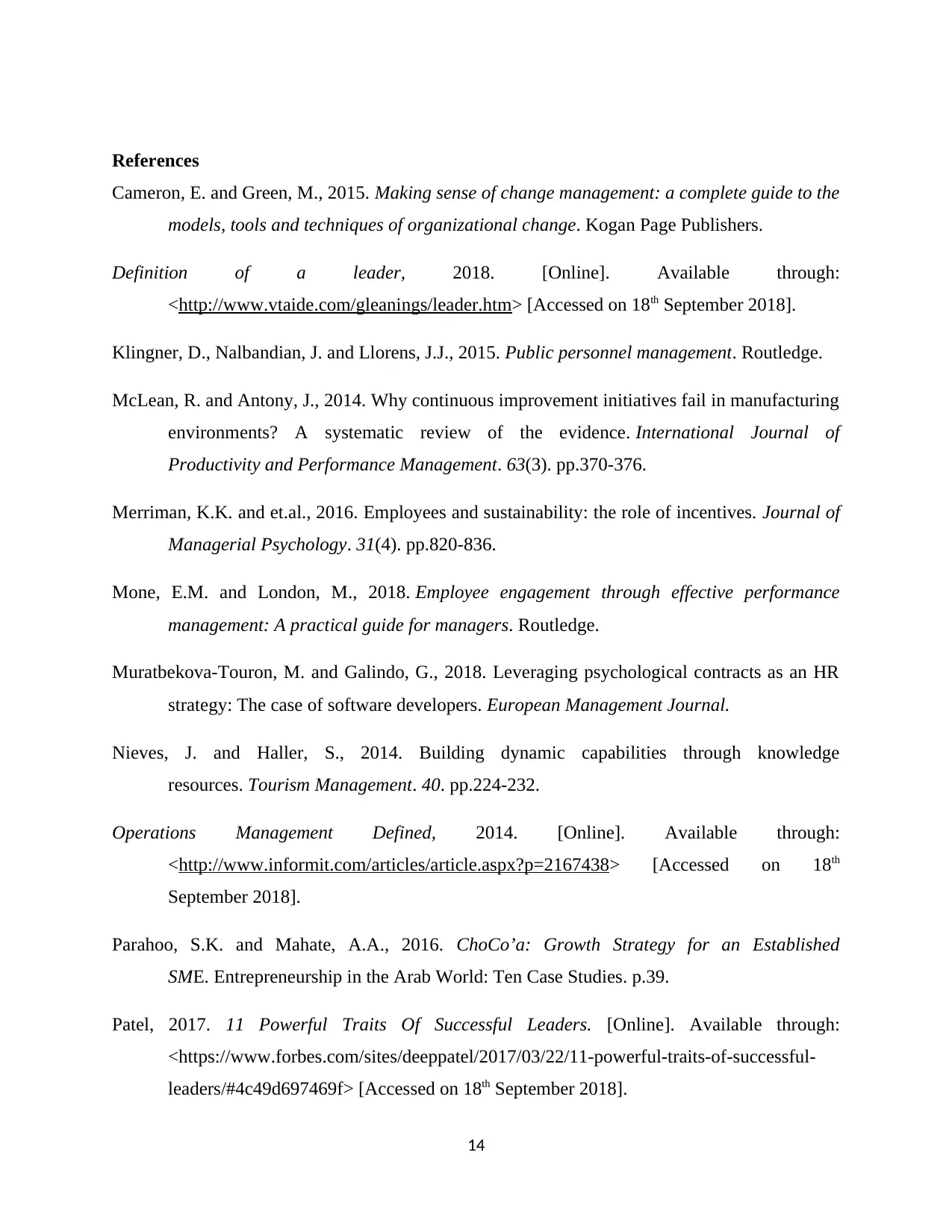
References
Cameron, E. and Green, M., 2015. Making sense of change management: a complete guide to the
models, tools and techniques of organizational change. Kogan Page Publishers.
Definition of a leader, 2018. [Online]. Available through:
<http://www.vtaide.com/gleanings/leader.htm> [Accessed on 18th September 2018].
Klingner, D., Nalbandian, J. and Llorens, J.J., 2015. Public personnel management. Routledge.
McLean, R. and Antony, J., 2014. Why continuous improvement initiatives fail in manufacturing
environments? A systematic review of the evidence. International Journal of
Productivity and Performance Management. 63(3). pp.370-376.
Merriman, K.K. and et.al., 2016. Employees and sustainability: the role of incentives. Journal of
Managerial Psychology. 31(4). pp.820-836.
Mone, E.M. and London, M., 2018. Employee engagement through effective performance
management: A practical guide for managers. Routledge.
Muratbekova-Touron, M. and Galindo, G., 2018. Leveraging psychological contracts as an HR
strategy: The case of software developers. European Management Journal.
Nieves, J. and Haller, S., 2014. Building dynamic capabilities through knowledge
resources. Tourism Management. 40. pp.224-232.
Operations Management Defined, 2014. [Online]. Available through:
<http://www.informit.com/articles/article.aspx?p=2167438> [Accessed on 18th
September 2018].
Parahoo, S.K. and Mahate, A.A., 2016. ChoCo’a: Growth Strategy for an Established
SME. Entrepreneurship in the Arab World: Ten Case Studies. p.39.
Patel, 2017. 11 Powerful Traits Of Successful Leaders. [Online]. Available through:
<https://www.forbes.com/sites/deeppatel/2017/03/22/11-powerful-traits-of-successful-
leaders/#4c49d697469f> [Accessed on 18th September 2018].
14
Cameron, E. and Green, M., 2015. Making sense of change management: a complete guide to the
models, tools and techniques of organizational change. Kogan Page Publishers.
Definition of a leader, 2018. [Online]. Available through:
<http://www.vtaide.com/gleanings/leader.htm> [Accessed on 18th September 2018].
Klingner, D., Nalbandian, J. and Llorens, J.J., 2015. Public personnel management. Routledge.
McLean, R. and Antony, J., 2014. Why continuous improvement initiatives fail in manufacturing
environments? A systematic review of the evidence. International Journal of
Productivity and Performance Management. 63(3). pp.370-376.
Merriman, K.K. and et.al., 2016. Employees and sustainability: the role of incentives. Journal of
Managerial Psychology. 31(4). pp.820-836.
Mone, E.M. and London, M., 2018. Employee engagement through effective performance
management: A practical guide for managers. Routledge.
Muratbekova-Touron, M. and Galindo, G., 2018. Leveraging psychological contracts as an HR
strategy: The case of software developers. European Management Journal.
Nieves, J. and Haller, S., 2014. Building dynamic capabilities through knowledge
resources. Tourism Management. 40. pp.224-232.
Operations Management Defined, 2014. [Online]. Available through:
<http://www.informit.com/articles/article.aspx?p=2167438> [Accessed on 18th
September 2018].
Parahoo, S.K. and Mahate, A.A., 2016. ChoCo’a: Growth Strategy for an Established
SME. Entrepreneurship in the Arab World: Ten Case Studies. p.39.
Patel, 2017. 11 Powerful Traits Of Successful Leaders. [Online]. Available through:
<https://www.forbes.com/sites/deeppatel/2017/03/22/11-powerful-traits-of-successful-
leaders/#4c49d697469f> [Accessed on 18th September 2018].
14

Peters, P. and et.al., 2014. Enjoying new ways to work: An HRM‐process approach to study
flow. Human resource management. 53(2). pp.271-290.
Pitt, M., and Koufopoulos D, N., 2012. Essentials on Strategic Management. Sage.
Quendler, E. and Lamb, M., 2016. Learning as a lifelong process-meeting the challenges of the
changing employability landscape: competences, skills and knowledge for sustainable
development. International Journal of Continuing Engineering Education and Life Long
Learning. 26(3). pp.273-293.
Singh, H. and et.al., 2017. Impact of Financial and Non-Financial Incentives on Employee
Performance. Advanced Science Letters. 23(1). pp.146-150.
Stanger, S. H. W. and et.al., 2012. What drives perishable inventory management
performance? Lessons learnt from the UK blood supply chain. Supply Chain
Management: An International Journal. 7(2). Pp.107-123.
Toyota, 2018. [Online]. Available through: <https://www.toyota-global.com/company/>
[Accessed on 9th November 2018].
Upadhaya, B., Munir, R. and Blount, Y., 2014. Association between Performance Measurement
Systems and Organisational Effectiveness. International Journal of Operations &
Production Management. 34(7). Pp. 2-2.
Welch, D. and Björkman, I., 2015. The place of international human resource management in
international business. Management International Review. 55(3). pp.303-322.
15
flow. Human resource management. 53(2). pp.271-290.
Pitt, M., and Koufopoulos D, N., 2012. Essentials on Strategic Management. Sage.
Quendler, E. and Lamb, M., 2016. Learning as a lifelong process-meeting the challenges of the
changing employability landscape: competences, skills and knowledge for sustainable
development. International Journal of Continuing Engineering Education and Life Long
Learning. 26(3). pp.273-293.
Singh, H. and et.al., 2017. Impact of Financial and Non-Financial Incentives on Employee
Performance. Advanced Science Letters. 23(1). pp.146-150.
Stanger, S. H. W. and et.al., 2012. What drives perishable inventory management
performance? Lessons learnt from the UK blood supply chain. Supply Chain
Management: An International Journal. 7(2). Pp.107-123.
Toyota, 2018. [Online]. Available through: <https://www.toyota-global.com/company/>
[Accessed on 9th November 2018].
Upadhaya, B., Munir, R. and Blount, Y., 2014. Association between Performance Measurement
Systems and Organisational Effectiveness. International Journal of Operations &
Production Management. 34(7). Pp. 2-2.
Welch, D. and Björkman, I., 2015. The place of international human resource management in
international business. Management International Review. 55(3). pp.303-322.
15
1 out of 15
Related Documents
Your All-in-One AI-Powered Toolkit for Academic Success.
+13062052269
info@desklib.com
Available 24*7 on WhatsApp / Email
![[object Object]](/_next/static/media/star-bottom.7253800d.svg)
Unlock your academic potential
© 2024 | Zucol Services PVT LTD | All rights reserved.





